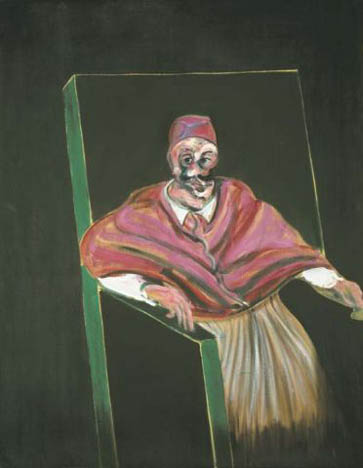
“I would like my pictures to look as if a human being had passed between them, like a snail, leaving a trail of the human presence and memory trace of past events as the snail leaves its slime”.
It is Francis Bacon (Dublin 1909-Madrid 1992) speaking and describing his works.
Following this idea, Italian art critic Giulio Carlo Argan commented the Study No. 1 after Velásquez’s portrait of pope Innocent X (1961).
“Bacon, the last sublime’s heir, sublimates but doesn’t idealize: therefore, for him ‘sublime’ is not a super condition, but a sub-human one, not sacred or divine but demoniac. In his whole work, it results he doesn’t believe in election or salvation, but to the degradation or the humanity’s fall: hence, also painting is not an elective process, but degradation. So that, it’s demystification is a brutal discovery of the truth under fiction”.
(…)
“In a series of six paintings, Bacon has analyzed Velásquez’s portrait of pope Innocent X.
In this one, he moves the figure to the right, sliding along the perspective, by receding the back of the chair. Then he erases the chair’s ornaments, reducing it to a gloomy perspective box that materializes the empty black space of background, trapping the figure. Once the balanced equilibrium with the background is broken, the figure appears deformed, as if only the difficult and precarious relationship with the space could give him a human physical appearance.
However, in fact, Bacon did nothing but exaggerate and weight down the original peculiarities, i.e. changing the bright reflexes on an eyebrow and the cheekbone into a livid-halo color, spinning ‘round his eye, changing the nose-direction and the opposite side of mustache, mouth and chin.
In other words Bacon ruins the Pope’s features by changing his expression from strong to weak, from determined to cunning, from severe to evil. But he does this following, step by step, the Velásquez’s method as to say that had he not been restrained by his respect for social conventions he would have managed to reveal the ‘true’ essence of the Pope
Really, Bacon’s cultural action is more complicated: it is easy to discover the painter has interpreted the Velásquez’s painting following El Greco’s way, that’s just the artist’s ascetic tendency to sublimating rapture, Velazquez has opposed his clear concept of reality.
What does Bacon want to demonstrate? (It doesn’t matter whether conscious or not), that’s enough to apply the reality, (the Velásquez’ one), the mysticism of sublimation and ecstasy, and just after the reality instead of getting spiritualized, it corrupts, decays becoming filthy and repugnant”.
Excerpt from: Giulio Carlo Argan, “L’arte moderna, 1770-1970”, 1999, Firenze, Sansoni editore, 1970. pp.450-1
http://www.diegovelazquez.org/
http://www.francis-bacon.com/
……………………………………………………………………………………………………………………………………………………………………………….
FRANCIS BACON NELLE PAROLE DI GIULIO CARLO ARGAN
“Vorrei che i miei quadri apparissero come se un essere umano fosse passato su di essi, lasciando una scia di umana presenza e tracce mnemoniche di eventi passati”.
Così Francis Bacon (Dublino 1909-Madrid 1992) stigmatizzava le proprie opere. Ed è proprio seguendo questa “logica” che il critico Giulio Carlo Argan lesse una delle infinite variazioni che l’artista di Dublino dedicò al tema dei papi, lo Studio n.1 dal ritratto di Innocenzo X del Velásquez (1961).
“Bacon, ultimo erede del “sublime”, sublima ma non idealizza: perciò il “sublime” non è, per lui, il super-, ma il sub-umano, non il sacro o il divino ma il demoniaco. Da tutta la sua opera risulta che lui non crede all’elezione o alla salvezza, ma alla degradazione o alla caduta dell’umanità: dunque anche la pittura non è un processo elettivo, ma degradante. Come tale è demistificazione, brutale scoperta della verità sotto la finzione.”
(…)
“In una serie di sei quadri Bacon ha analizzato il ritratto di Innocenzo X di Velásquez. In questo, sposta la figura verso destra per farla scorrere lungo la prospettiva dello schienale e farla apparire “sfuggente”. Elimina gli ornamenti della poltrona, la riduce a una lugubre scatola prospettica che materializza lo spazio nero e vuoto del fondo, imprigionandovi la figura. Rotta così ogni relazione di equilibrio col fondo, la figura si deforma, come se fosse soltanto quel difficile e precario rapporto con lo spazio a darle un aspetto umano. Di fatto, però, Bacon si limita a esagerare e appesantire i motivi pittorici dell’originale: per esempio, a trasformare le note luminose sul sopracciglio e sullo zigomo in un alone livido e vorticoso intorno all’occhio, a invertire la direzione del naso, a storcere dalla parte opposta il baffo, la bocca, il mento. In altre parole, sfigura la figura di Velásquez; ne stravolge l’espressione da forte in debole, da volitiva in astuta, da severa in malvagia. Ma lo fa seguendo passo per passo il processo di Velásquez: come per dire che, se non l’avesse fermato il rispetto delle convenzioni, sarebbe arrivato a scoprire la vera figura del papa. In realtà, però, l’operazione di Bacon è più complicata: è facile accorgersi che ha interpretato il quadro di Velásquez al modo del Greco, cioè proprio dell’artista alla cui ascetica tendenza alla sublimazione Velasquez ha opposto il proprio lucido, obbiettivo concetto della realtà. Che cosa (e non importa se consapevolmente o non) vuole dimostrare Bacon? Che basta applicare alla realtà (la realtà di Velásquez) il misticismo della sublimazione e dell’estasi, e subito la realtà, invece di “spiritualizzarsi”, si corrompe, marcisce, diventa schifosa e ripugnante”.
Da Giulio Carlo Argan, “L’arte moderna, 1770-1970”, 1999, Firenze, Sansoni editore, 1970. pp.450-1